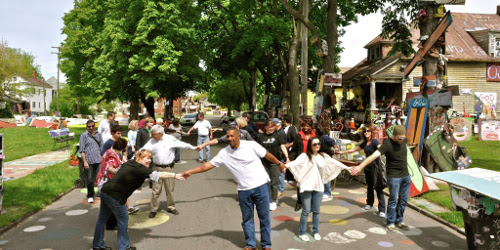BY AJ TRAGER

Founder of the Heidelberg Project Tyree Guyton (center) with some of the many volunteers who donate their time and energy to cleaning up Heidelberg Street. Photo by Geronimo Patton.
DETROIT – From fast food wrappers to decrepit couches, metropolitan areas often struggle with trash.
Detroit Mayor Duggan, at the 2016 Motor City Makeover campaign kickoff held April 19, said that the city is dramatically cleaner than a few years ago.
"There's far less trash, there's far less graffiti and there are far fewer vacant buildings," Duggan said. "But we have a long way to go. Government can't do everything, and we're asking people to pitch in."
One organization has been committed to cleaning up the negativity in the city for the past 30 years: the Heidelberg Project.
The concept started in 1986 with an artist, Tyree Guyton, who returned to the street he grew up on only to find it in disarray, riddled with drugs and deep in poverty. What used to be a diverse, working class neighborhood had become a community characterized by violence, abandonment, despair and poverty.
As a response to ongoing blight and decay in the neighborhood, Guyton and his grandfather began cleaning up the vacant lots on Heidelberg Street. He then transformed the street by using the found objects he collected to create art installations on vacant homes, sidewalks and trees.
"We use things and recycle things, but ultimately we're hoping to save the human spirit," Jenenne Whitfield, executive director of the Heidelberg Project, told BTL.
Over the course of its lifetime, the Heidelberg Project has experienced some rocky moments from theft and vandalism to a series of fires in 2013 that decimated 12 of the artistic sites. Today only three remain.
"The message is the work isn't so much about preserving things, it's about celebrating joy and hope in the individual. The fires are about a sacrifice. Let us show you how we can resurrect and respond and that it won't be catastrophic," Whitfield said.
The spaces where the fire-engulfed homes once stood have since been transformed with the help of the many Heidelberg Project volunteers.
Preserving the Heart and Soul of Detroit
"This work has been about so much more than just art, but it's the catalyst," Whitfield told BTL.
Whitfield is a born and raised Detroiter. In 1993, after years of working as a banker and climbing the corporate ladder, she dropped the high paying gig and settled into her seat at the Heidelberg Project. She's been with the company for 23 years and firmly believes that art has the power to create change in one's own life and helps to transform the heart of an individual.
"What we have done with the project is welcome all people. Especially those that feel something from that street — from the discarded pieces that have been given new life," she said. "We want to embrace Detroit and to us, Detroit is Metro Detroit. We want to learn how to better put our arms around ourselves and our culture and appreciate the city. That's for the people that have been here and those that are coming here."
The organization's mission begins with the belief that all citizens, from all cultures, have the right to grow and flourish in their communities and that to redevelop and sustain a community, members must embrace the diverse culture and artistic attributes as the essential building blocks for a fulfilling and economically viable way of life.
As the city of Detroit and the surrounding Metro Detroit area continue to develop and build stronger community networks, the Heidelberg Project serves as a reminder for the public to reconnect with the the essence of what it means to be a Detroiter — to fight for visibility and the destigmatization of the area.
"We're not a part of a quick fix. It took a lot of time to beat people down in communities where they felt they had no hope. You can't heal the city until you heal the minds of the people. You build a bunch of new houses and some retail, but there's no economic base — no jobs. You cannot sustain that. We're starting at ground zero so to speak. The idea is that you first have to get people used to other kinds of people, and help them understand that they have value and can be participants in the revitalization in their community," Whitfield said.
The evidence of their work is not necessarily seen in new development but instead is seen in the energy of the people within the community. Whitfield believes that to truly revitalize a city, one must start with the men and women that live there.
Midtown and other sections of downtown Detroit are feeling the effects of the efforts to bring new businesses and fresh minds to the city's business infrastructure and the economic market. As a native of the city, Whitfield believes that the Detroit community will best thrive by establishing local thought leaders at the planning table who can demonstrate how Detroit can be a new city that is more equitable.
"People make the world go round, not things. You can bring in big money and you can force people out, but you'll be surrounded by a pool of poverty. And if we don't find a way to raise the level of consciousness, that's going to turn inward. You'll see a riot and people pushing out folks. This is a different kind of city," she said.
However, Detroit is home to many people that are committed to the community and share in their interests for health food, community gardens, community organizing, stronger schools and learning more about other people.
"What I'm feeling and pushing for and what Heidelberg is pushing for is a shift in consciousness. And you can't be afraid," she said.
30 Years of Heidelberg
In celebration of 30 years, the project began a monthly campaign in August 2015 that shares tidbits about education or a "blast from the past" launched from the Heidelberg archives. The team wants to educate the city first on the accomplishments of the last 30 years while celebrating the current atmosphere the project has helped to create on Heidelberg Street and throughout the city.
As for Guyton's artistic work, the Heidelberg Project has partnered with Shinola and Detroit Bikes to design an installation centered around clocks. The watch project is still in the planning stages.










